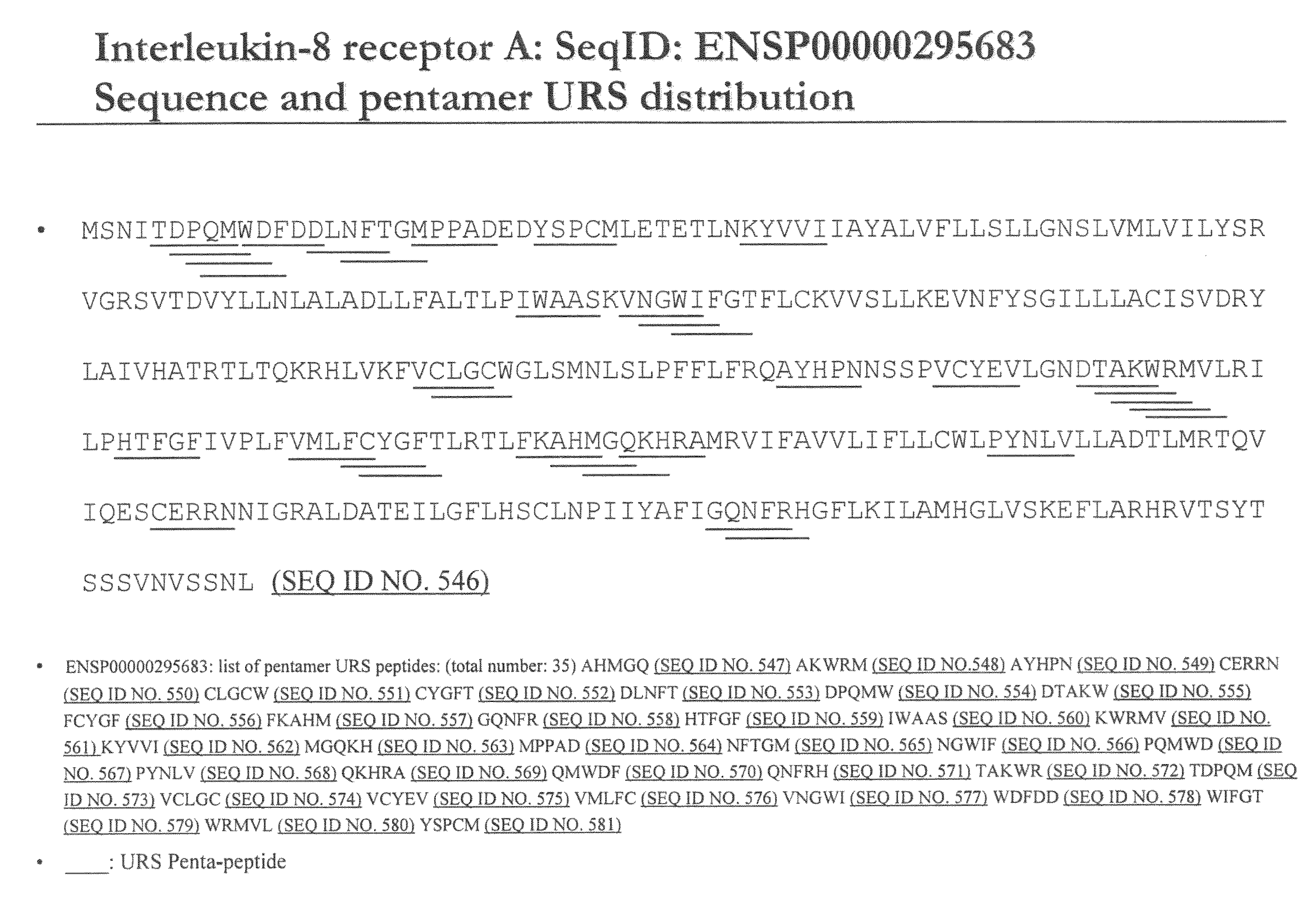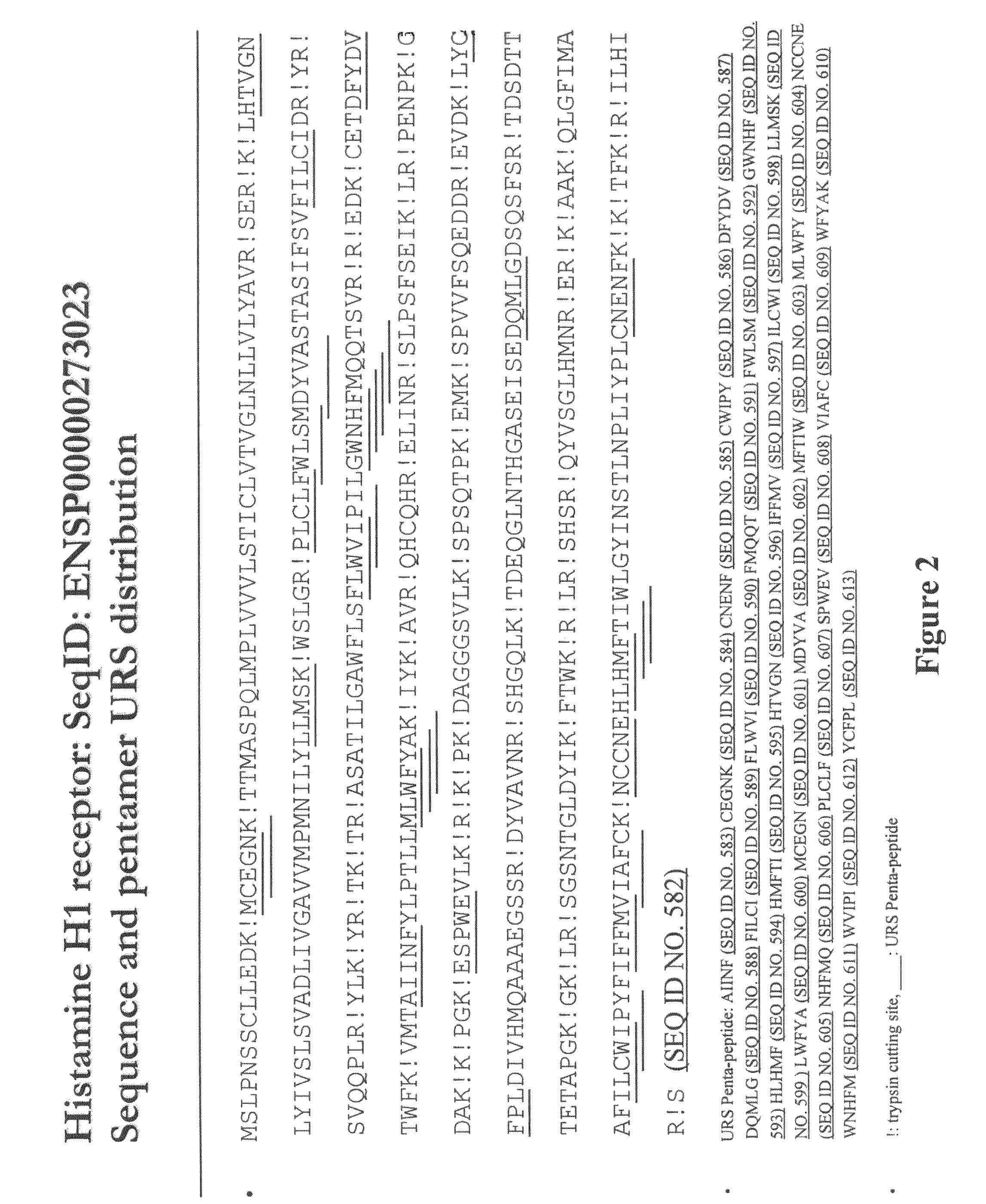Proteome epitope tags and methods of use thereof in protein modification analysis
a protein and epitope technology, applied in the field of proteome epitope tags and methods of protein modification analysis, can solve problems such as significant background issues, and achieve the effect of improving the clinical value of the psa test and improving the sensitivity/selectivity of the assay
- Summary
- Abstract
- Description
- Claims
- Application Information
AI Technical Summary
Benefits of technology
Problems solved by technology
Method used
Image
Examples
example 1
Identification of Unique Recognition Sequences within the Human Proteome
[0499]As any one of the total 20 amino acids could be at one specific position of a peptide, the total possible combination for a tetramer (a peptide containing 4 amino acid residues) is 204; the total possible combination for a pentamer (a peptide containing 5 amino acid residues) is 205 and the total possible combination for a hexamer (a peptide containing 6 amino acid residues) is 206. In order to identify unique recognition sequences within the human proteome, each possible tetramer, pentamer or hexamer was searched against the human proteome (total number: 29,076; Source of human proteome: EBI Ensembl project release v 4.28.1 on Mar. 12, 2002, http: / / www.ensembl.org / Homo—sapiens / ).
[0500]The results of this analysis, set forth below, indicate that using a pentamer as a unique recognition sequence, 80.6% (23,446 sequences) of the human proteome have their own unique recognition sequence(s). Using a hexamer as...
example 2
Identification of Unique Recognition Sequences (or PETS) within all Bacterial Proteomes
[0508]In order to identify pentamer PETs that can be used to, for example, distinguish a specific bacterium from a pool of all other bacteria, each possible pentamer was searched against the NCBI database (http: / / www.ncbi.nlm.nih.gov / PMGifs / Genomes / eub_g.html, updated as of Apr. 10, 2002). The results from this analysis are set forth below.
[0509]Results and Data:
Number ofDatabase IDunique(NCBIpentamersRefSeq ID)Species Name6NC_000922Chlamydophila pneumoniae CWL02937NC_002745Staphylococcus aureus N315 chromosome40NC_001733Methanococcus jannaschii small extra-chromosomal element58NC_002491Chlamydophila pneumoniae J13884NC_002179Chlamydophila pneumoniae AR39135NC_000909Methanococcus jannaschii206NC_003305Agrobacterium tumefaciens str. C58 (U.Washington) linear chromosome298NC_002758Staphylococcus aureus Mu50 chromosome356NC_002655Escherichia coli O157: H7 EDL933386NC_003063Agrobacterium tumefaciens s...
example 3
Identification of Specific PETS
[0510]FIG. 11 outlines a general approach to identify all PETs of a given length in an organism with sequenced genome or a sample with known proteome. Briefly, all protein sequences within a sequenced genome can be readily identified using routine bioinformatic tools. These protein sequences are parsed into short overlapping peptides of 4-10 amino acids in length, depending on the desired length of PET. For example, a protein of X amino acids gives (X−N+1) overlapping peptides of N amino acids in length. Theoretically, all possible peptide tags for a given length of, for example, N amino acids, can be represented as 20N (preferably, N=4−10). This is the so-called peptide tag database for this particular length (N) of peptide fragments. By comparing each and every sequence of the parsed short overlapping peptides with the peptide tag database, all PET (with one and only one occurrence in the peptide tag database) can be identified, while all non-PET (wi...
PUM
| Property | Measurement | Unit |
|---|---|---|
| length | aaaaa | aaaaa |
Abstract
Description
Claims
Application Information
 Login to View More
Login to View More - R&D
- Intellectual Property
- Life Sciences
- Materials
- Tech Scout
- Unparalleled Data Quality
- Higher Quality Content
- 60% Fewer Hallucinations
Browse by: Latest US Patents, China's latest patents, Technical Efficacy Thesaurus, Application Domain, Technology Topic, Popular Technical Reports.
© 2025 PatSnap. All rights reserved.Legal|Privacy policy|Modern Slavery Act Transparency Statement|Sitemap|About US| Contact US: help@patsnap.com



